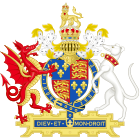Chester and Cheshire (Constituencies) Act 1542
Appearance
This article needs additional citations for verification. (September 2008) |
 | |
| Long title | An Act for Knights and Burgesses to have Places in the Parliament for the County Palatine and City of Chester |
|---|---|
| Citation | 34 & 35 Henry VIII c. 13 |
| Territorial extent | Kingdom of England |
| Dates | |
| Commencement | 1 October 1543 |
| Repealed | 30 July 1948 |
| Other legislation | |
| Repealed by | Representation of the People Act 1948 |
Status: Repealed | |
| Text of statute as originally enacted | |
Chester and Cheshire (Constituencies) Act 1542 (34 & 35 Henry VIII c. 13) is the Act of Parliament allowing Cheshire to be represented in the Parliament of England. The county palatine of Chester, ruled by the earls of Chester was established by William the Conqueror. Cheshire had its own parliament, consisting of barons of the county, and was not represented in the parliament of England. After the passing of the act Cheshire retained some of its special privileges until 1830. The earldom of Chester is traditionally vested in the sovereign's eldest son upon his crowning as Prince of Wales.
The Act was repealed by section 80 of, and Schedule 13 to, the Representation of the People Act 1948 (c.65).
References
- 34 & 35 Henry VIII c. 13, An Act for Knights and Burgesses to have Places in the Parliament for the County Palatine and City of Chester — in Raithby, John; Tomlins, Sir Thomas Edlyne (1811). The statutes at large, of England and of Great Britain: from Magna Carta to the union of the kingdoms of Great Britain and Ireland, Volume 3: 1509–53. London: Printed by George Eyre and Andrew Strahan. (Full text of the Act as passed, from Google Books scan)
